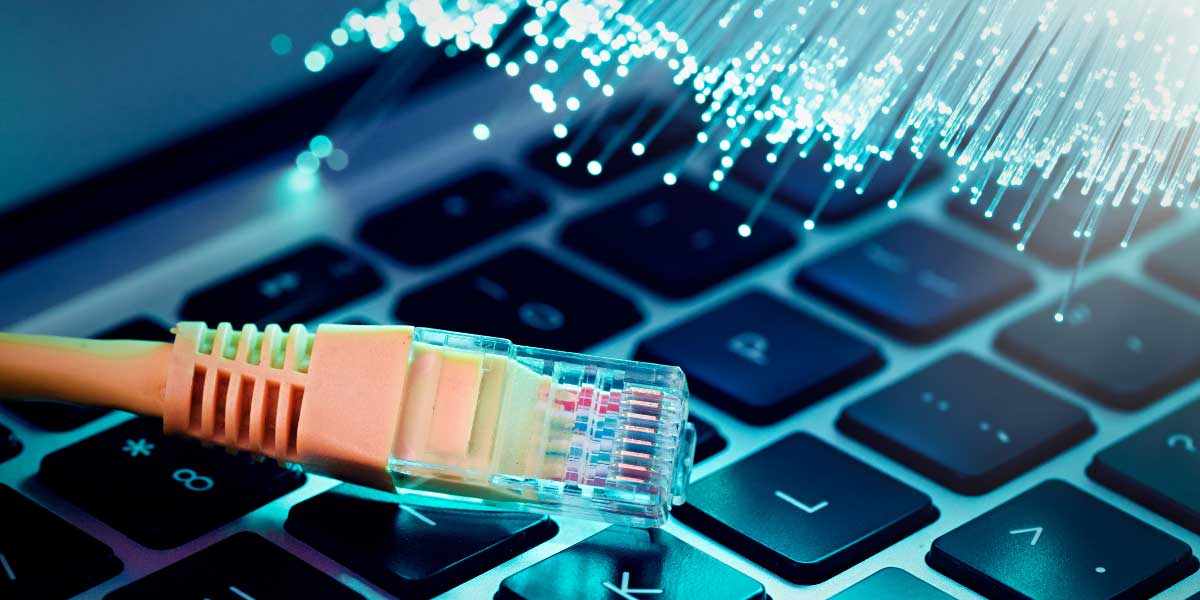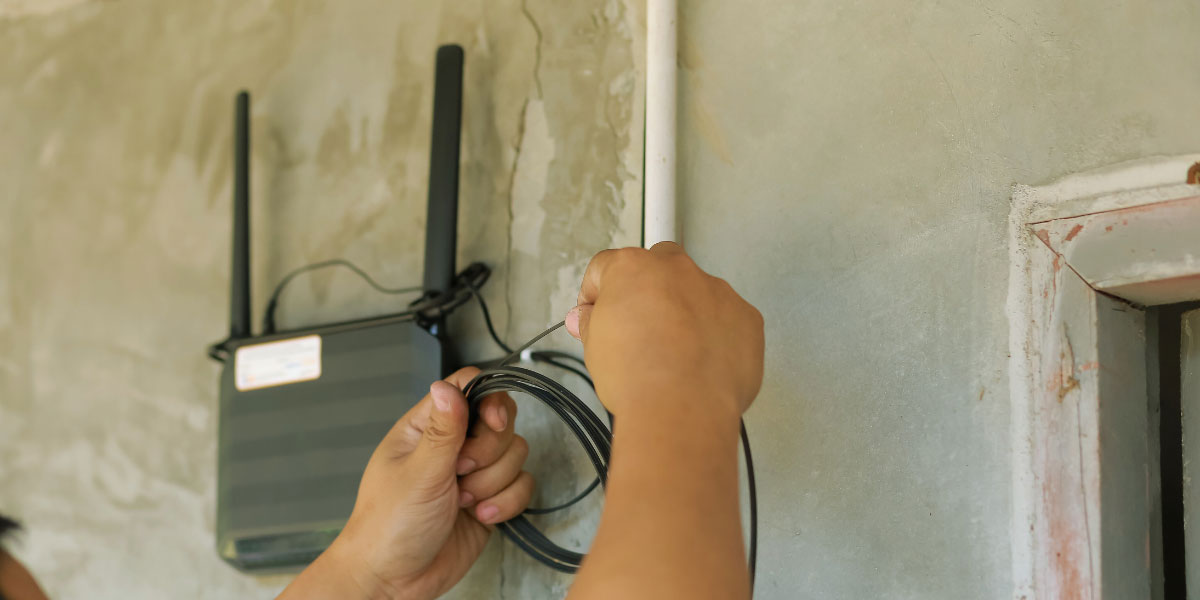What is Fiber Internet, And How Does It Work?

Fiber-optic Internet is an internet connection that uses light pulses to transmit data. This results in faster speeds, lower latency, and greater bandwidth than traditional copper-based internet connections.
Fiber optic cables are made of hair-thin strands of glass that are much more efficient at transmitting data than copper wires. This means that fiber optic internet can provide up to 1 gigabit per second (Gbps), much faster than the average cable or DSL connection.
Fiber optic internet is also more reliable than copper-based internet connections. The glass fibers are less susceptible to interference and signal loss. As a result, fiber optic internet is a good choice for businesses and homes that require a high-speed, reliable internet connection.
This article will explain what fiber internet is, how it works, the history of fiber optics, how it differs from other internet connections, the speed and latency benefits of fiber, and more. Keep reading to learn all about this exciting internet technology!
All About Optical Fiber and How it Works
Optical fiber is the key technology that has enabled the high-speed fiber optic communications revolution. An optical fiber is a flexible and transparent fiber made of high-purity glass or plastic that transmits light down its length by total internal reflection. Each fiber acts as an independent channel for data transmission.
Optical fibers are used for fiber optic communications because they allow transmission over longer distances and have lower attenuation than electrical cables. Fibers are immune to electromagnetic interference that can disrupt electrical signals.
Optical fibers suitable for long-distance telecommunications typically have an extremely low signal loss of less than 0.2 dB per km. They maintain a much higher signal over long distances than coaxial cable or copper wire.
The development of low-loss optical fiber in the 1970s enabled the use of fiber optics for long-distance communications. The first fiber optic telephone transmission system became operational in 1977. Fiber optics revolutionized telecommunications and paved the way for the Internet as we know it today by transmitting pulses of light through glass rather than electricity over metal.
Read also: Google Fiber Vs Spectrum: Which ISP is Best For You?
Types of Fiber Optic Cable
There are two main types of fiber optic cable designs exist:
- Single mode
- Multimode
Singlemode fiber has a small core diameter (8-10 microns) and only allows one transmission path or mode for light to pass through. It can transmit signals over much greater distances of tens of kilometers.
Multimode fibers have a larger core (50-100 microns) that permits multiple modes or light paths. Multimode is mainly used for short-distance communication links within buildings and data centers. While multimode fiber bandwidth has improved, single mode delivers the fastest speeds and highest bandwidth efficiency for long-haul fiber optic communications.
History of Fiber Optics
The history of fiber optics began in the late 19th century, but fiber optic telecommunication technologies exploded starting in the 1970s. Some key milestones in the development of fiber optic technology include:
- 1870 – John Tyndall demonstrates the internal reflection of light in a water stream.
- 1930s – Heinrich Lamm develops medical endoscopes using fiber bundles to transmit images.
- 1950s – Narinder Kapany conducts experiments transmitting images through fiber bundles called “optical fibers.”
- 1966 – Charles Kao and George Hockham determined glass fibers could transmit light over long distances and described the feasibility of fiber optic communications.
- 1970 – Researchers at Corning Glass Works produce fibers with 20 dB/km signal loss, making fiber optics practical.
- 1977 – General Telephone and Electronics install the first live fiber optic telephone link in Long Beach, California, transmitting at 6 Mbit/s.
- 1988 – The first transatlantic telephone cable, TAT-8, begins operation with two optical fiber pairs transmitting 40,000 phone calls simultaneously.
- 1991 – Installation of the first fiber to the home systems begins as an alternative to copper.
- 1996 – Telecommunications Act passed to deregulate local phone services and spur fiber optic network growth.
- 2000s – Widespread commercial deployment of fiber to the home by Verizon FiOS, Google Fiber, and others for high-speed broadband.
- 2010s – Ongoing improvements in fiber optic speeds, bandwidth density, and economics.
From these humble beginnings, fiber optic technology has exploded beyond telecommunications to become widely adopted for computer networking, cable television, industrial imaging, sensors, and countless other cutting-edge applications. The global fiber optics market continues to grow rapidly, driven by surging internet traffic and demand for high-bandwidth 5G wireless networks.
How Does Fiber Internet Work?
Fiber optic internet turns electrical information from your device into optical light signals sent through transparent glass fibers.
A fiber optic cable contains many optical fibers, each about the width of a human hair. These fibers are made of high-quality extruded glass called silica. Each optical fiber has a cylindrical core surrounded by cladding material of a lower refractive index.
Your device’s information is converted into laser light signals at one end of the fiber optic cable. This is done by a fiber optic transmitter, usually a semiconductor laser or LED. The light pulses flow through the optical fiber, reflecting off the cladding and core as they propagate down the length of the cable.
At the other end of the fiber is a photodetector, which converts the light pulses back into electrical information readable by computers and other devices. The light signals remain confined within the core of each fiber for distances up to several kilometers with very little signal loss or interference between fibers.
Read also: Xfinity Vs Ziply: Is Ziply Fiber Better Than Xfinity?
How Fiber Internet Differs From Other Connections
What distinguishes fiber internet from broadband connections like cable, DSL, and satellite? Several key differences make fiber superior in speed and overall performance.
Dial-up Internet
First-generation home internet access used analog dial-up connections over telephone lines. With dial-up, speeds max out around 56 Kbit/s. While revolutionary, dial-up is now considered obsolete and painfully slow compared to fiber optics transferring data at up to 1 Tbit/s. Dial-up also ties up your phone line while in use.
DSL Internet
DSL stands for Digital Subscriber Line. This technology uses high-frequency signals over telephone copper wiring to provide faster internet speeds than dial-up, typically in the range of 1.5 to 50 Mbps for residential subscribers. However, speeds degrade rapidly with distance from a DSL provider’s central office. DSL still cannot match the bandwidth or consistency of fiber optic connections.
Cable Internet
Cable internet operates over the same coaxial cables used for cable TV service. It offers speeds ranging from 50 Mbps to 1 Gbps using DOCSIS technology to divide the cable line into channels. But since channels are shared, heavy traffic results in slower speeds for all users. Fiber optics provide each user with a dedicated line without congestion issues.
Fiber optic cables are not subject to the distance limitations of DSL nor the congestion issues with shared cable lines. Fiber optics offer symmetrical upload and download speeds rather than slower uploads typical of cable and DSL.
With no shared bandwidth or electrical interference, each fiber strand can deliver consistently ultrafast speeds to each home or business. This makes fiber internet the top choice for performance-intensive activities like 4K streaming, online gaming, video conferencing, and more.
Read also: Blue Stream Vs Comcast: Who Has Better Internet Service?
Is Fiber Internet Faster that Others?
Without question, fiber internet offers unmatched speed and performance compared to legacy broadband technologies:
[1] Faster speeds – Fiber commonly delivers 1 Gbps, with speeds up to 10 Gbps now available. This dwarfs DSL and cable maximum speeds.
[2] Lower latency – Fiber optics have much lower latencies due to faster light transmission. This results in much less gaming, voice, and video chat lag.
[3] Symmetrical speeds – Fiber offers equal fast uploads and downloads. Cable and DSL have slower uploads limiting uses like video streaming.
[4] No throttling – Fiber has dedicated bandwidth that is never throttled based on traffic. Cable and DSL may suffer slowdowns during peak use.
[5] Higher reliability – The glass fiber medium is less susceptible to electrical interference leading to higher uptime.
[6] Future-proof – Fiber has unlimited bandwidth potential through additional wavelengths, new fiber lines, and speed-boosting technologies.
With broadband speeds doubling every two years, copper cable and DSL must catch up. Only fiber has the scalability to meet future speed demands for emerging bandwidth-heavy use cases like virtual reality, autonomous vehicles, smart cities, and more. While fiber deployment costs are higher, the fiber optic cable has a useful life measured in decades, future-proofing internet infrastructure.
Benefits of Fiber Internet For Users

For both residential and business users, fiber optic internet unlocks new levels of connectivity and performance simply not possible with legacy broadband:
Media Streaming
Fiber allows seamless streaming of 4K, 8K, and emerging 3D video formats that would choke other connections. Entire families can stream simultaneously over fiber without buffering or quality degradation.
Smart Home and IoT
Home automation, security systems, telemedicine, and other IoT applications require robust, high-bandwidth connections. Fiber supports entire smart homes with dozens of connected devices.
Remote Work and Learning
Video conferencing, cloud computing, and online collaboration thrive with fiber’s fast, low-latency connections. Fiber also enables access to immersive virtual classrooms and training systems.
Online Gaming
Serious online gamers demand fiber’s fast speeds and minimal lag. Fiber enables smooth 4K gaming, augmented reality multiplayer, and game streaming services.
Telecommuting
With enterprise-level speeds and quality, fiber lets employees productively work from home. Large files, real-time video calls, and remote system access are no problem.
Small Businesses
Fiber connectivity supercharges small business productivity with cloud systems. Fiber also enables customer experiences not possible before, such as virtual showrooms.
For consumers, fiber unlocks the full potential of internet video, gaming, and smart home innovation. For enterprises, fiber provides a platform for growth by transforming customer experiences and empowering remote work. Truly, fiber optic internet offers breakthrough capabilities beyond what copper wire connections can deliver.
What is Dark Fiber?
Within a fiber optic network, unused fiber cables are referred to as “dark fiber” because no light signals are being transmitted. While inactive, dark fiber still holds great potential value.
With the major expense of physically laying fiber optic lines, service providers often install extra dark fiber capacity for future use as bandwidth demands grow. Dark fiber may also be leased to other providers or large enterprises looking to build dedicated high-speed connections.
Dark fiber also helps future-proof networks for the next generation of broadband, 5G wireless, and Internet of Things applications requiring huge fiber capacity.
So, in summary, dark fiber represents latent network potential waiting to be activated.
Conclusion
From its origins in the 19th century, fiber optic technology has come a long way to revolutionize modern digital communications. With nearly unlimited capacity and unrivaled speeds, fiber internet represents the future of home and business connectivity.
Fiber empowers limitless applications from 4K video streaming to cloud computing that other internet connections struggle to support. While fiber rollout continues, the benefits for users are clear – fiber means unmatched performance for today and tomorrow.
